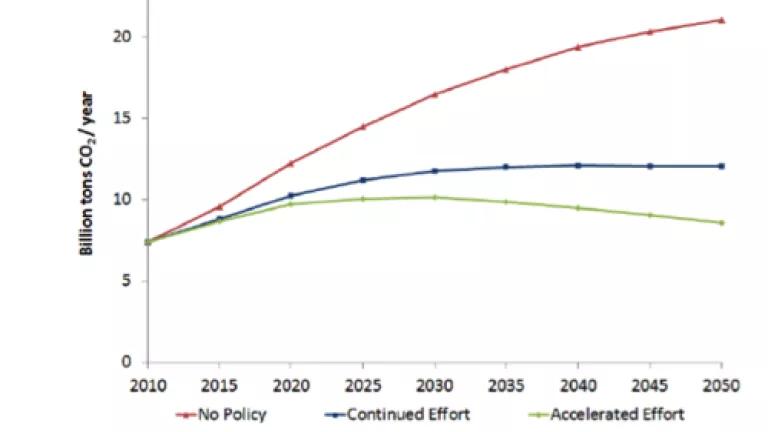
Chinese President Xi and President Obama just made a huge announcement. They committed to even deeper cuts in their climate pollution than many expected was achievable just a few short years ago. They specified targets that clearly signal that both countries are prepared to be bold and ambitious. These commitments will help secure a strong international agreement next year when leaders are to finalize the next round of international climate commitments.
China committed to peak its carbon pollution by 2030, with the intention to try to peak earlier. The United States committed to cut its emissions 26-28 percent below 2005 levels by 2025. Both are strong and achievable targets. As NRDC’s President Frances Beinecke reacted:
“These landmark commitments to curtail carbon pollution are a necessary, critical step forward in the global fight against climate change. We look forward to working with both governments to strengthen their efforts--because we are confident that both can achieve even greater reductions.”
These are important emission reduction targets that require strong action from both countries.
In recent years, China has put in place major programs on energy efficiency and renewable energy –breaking all previous renewable energy deployment records. Yet, its continued reliance on coal remains its major energy and climate challenge. Projections of Chinese emissions have consistently shown that their emissions would grow significantly in the coming decades without new action. There are predictions that Chinese emissions could peak early without new action – but predictions aren’t a guarantee of reality. A recent estimate from leading researchers at MIT and Tsinghua University found that without strong actions, China’s emissions could grow with no peak in sight. These researchers found that China’s emissions would peak in 2030 under their most aggressive scenario – the “Accelerated Effort” (see figure). One look at the types of measures they analyzed to meet this scenario and you’ll see that achieving this will require strong action from China.
Credit: MIT and Tsinghua University, 2014
NRDC’s work with leading government think-tanks, research institutes, and industry associations in China is focused on achieving a coal consumption peak no later than 2020. Since coal is the major source of China’s carbon emissions, a national policy that peaks coal consumption by 2020, and an ambitious implementation plan to achieve it, will help ensure that China’s overall CO2 emissions peak before 2030 and at a low level. We are confident that China can peak its CO2 emissions by 2030 and earlier, but only if China is bold and ambitious in addressing its over-reliance on coal that is driving both air and climate pollution.
The U.S. commitment is similarly achievable with strong, sustained actions to reduce emissions. Under existing law the U.S. can meet the deep targets it committed to – to cut total national emissions to 28 percent below 2005 levels by 2025. President Obama has set in motion many carbon-cutting actions pursuant to his earlier target of cutting U.S. carbon emissions 17 percent below 2005 levels by 2020. The U.S. can meet both its 2020 and 2025 targets using existing laws like the Clean Air Act and energy efficiency laws. New acts of Congress may be needed in the long-term, but the U.S. President can take a big bite out of U.S. climate pollution using the laws already on the books.
We have consistently found that a reduction of 28 percent below 2005 levels by 2025 can be met with implementation of existing law. The U.S. will need to use the key tools at its disposal. This means strengthening the carbon pollution standards for the power sector, implementing the oil and gas methane standards that many have called for, implementing the standards to reduce the climate pollution of coolants used in air conditioners and refrigerators, ensuring that our transportation system is smarter, and reducing the energy used by our buildings and appliances. These can be achieved cost-effectively, help create jobs, and achieve important health benefits for our children.
The commitment from China and the U.S. is a powerful signal to other countries that an ambitious agreement next year in Paris that significantly reduces rising emissions is achievable. Combined with the recently strengthened commitment from the European Union, the announcement from the U.S. and China means that countries accounting for more than fifty percent of the world’s emissions have now come forward with their new climate targets. Hopefully others sitting on the sidelines will now get off the bench and step forward in the coming months with clear commitments that significantly cut their carbon pollution.
These targets from China and the U.S. are historic. Two of the biggest emitters in the world, the world’s largest economies, and historically the major barriers to international climate action have just announced that they will commit to even greater cuts in carbon pollution. They are signaling that they are ready to implement even more action at home in the coming years. Achieving and surpassing these new commitments is doable. China and the U.S. can’t sit back and wait for the future. They’ll have to act now to spur even greater action.
We are confident that they can do it.

